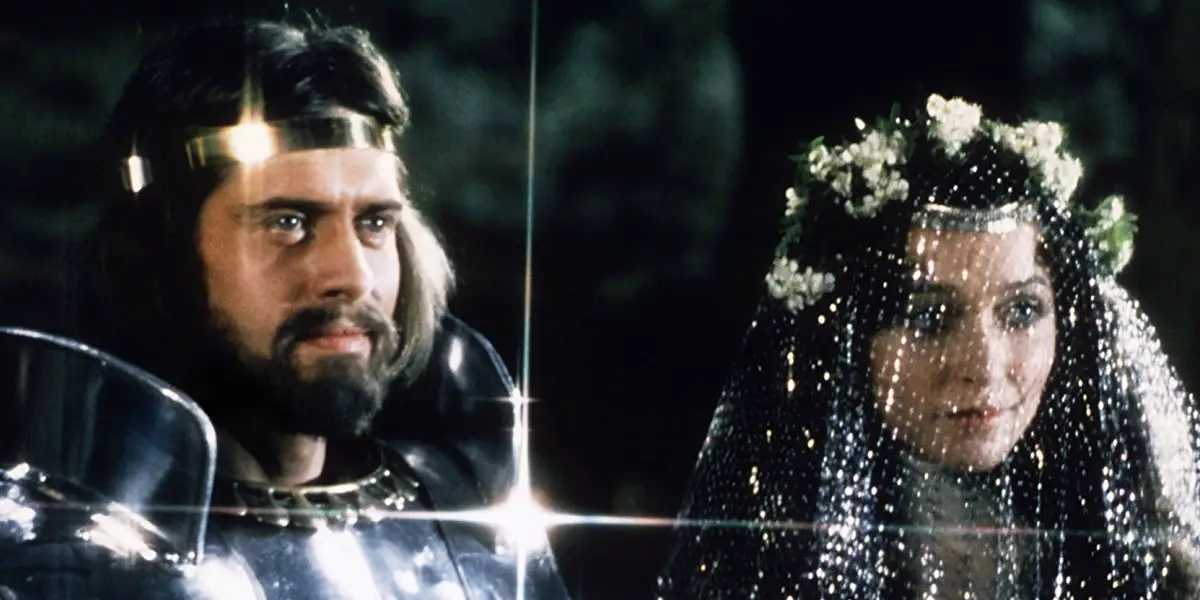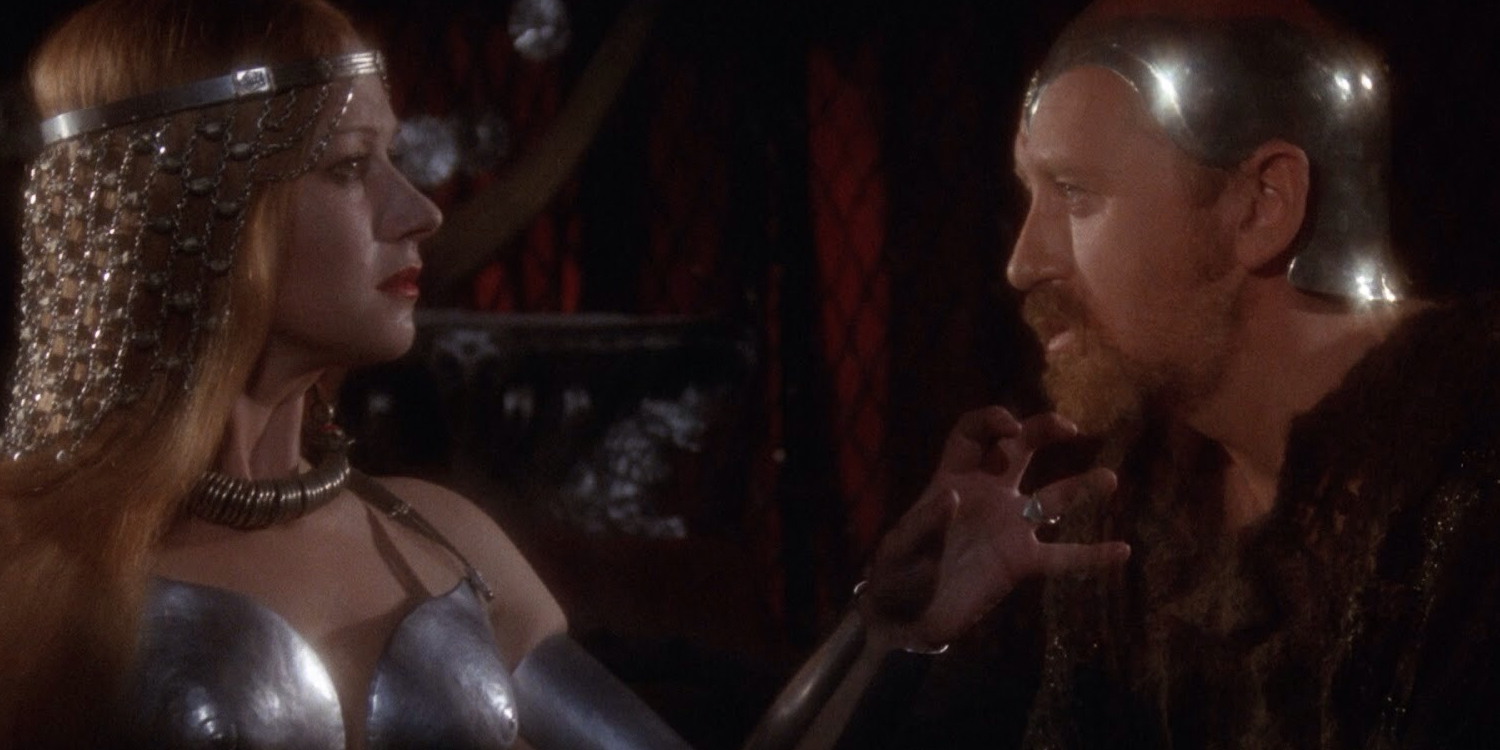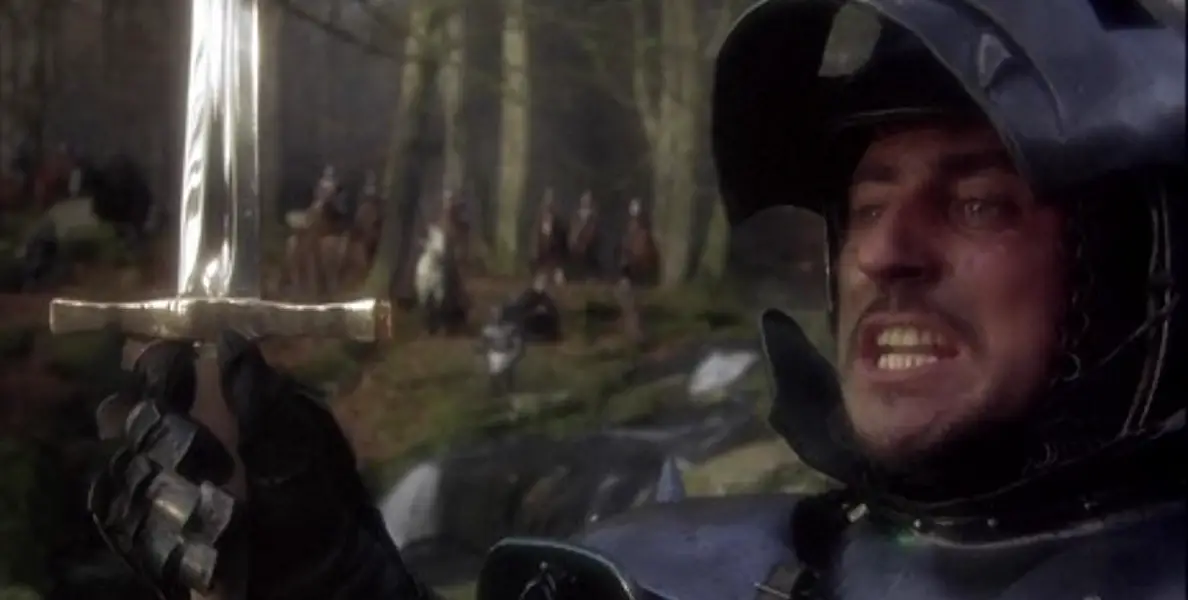EXCALIBUR: Is This The Best King Arthur Movie?

Frank H. Wu is William L. Prosser Distinguished Professor at…
The best King Arthur movie remains John Boorman’s Excalibur. I was not allowed to see it when it premiered in the theaters. The release was rated “R” and my mother was strict about these matters. No doubt that is why I am entranced by cinema now that I can watch whatever I want.
Excalibur deserved the restricted designation. It has nothing in common with Disney’s The Sword in the Stone , except that in both accounts of the tale, Arthur frees Excalibur, the titular weapon, by accident. A humble page, adopted as brother to Kay, the boy has forgotten the sword for his elder who is about to joust, and, hurrying to rectify his error, he spies the blade and draws it, without quite appreciating the significance of the act.
His true lineage revealed, he ascends as the magus Merlin intended.
It is for that reason that King Arthur inspires dreams. A teenager of no promise, envisioning no special future, turns out to be a born leader, an individual unique in ability. Then he gains immediately a lover, a best friend, admirers, and followers.
How Arthur Became King
This version, however, offers the backstory. Uther Pendragon seduced the wife of his new ally, disguised as the cuckold by the sorcery of Merlin. The child of the union is Arthur, who, according to the bargain that was struck, is appropriated by the wizard for his own purposes. Uther lost his position and his life. He buried his sword in a boulder with his dying breath.

The sex and the violence is all depicted, as well as the violence of sex. The other important birth is Arthur’s son Mordred, progeny of the bed trick played by Morgana, who has learned the secrets of Merlin. He thus is a product of incest, Morgana being half-sister to Arthur through their mother, and he has been raised as a golden child by Morgana to usurp Arthur.
A crow pecks out the eyeball from a rotting corpse, which has been hung in a forest of murdered Knights of the Round Table. They have been systematically eliminated while on the quest for the Holy Grail. Only Sir Perceval remains. He has realized that the king and the land are one and the same. If the king is healthy, the land will prosper. But the king is gray, weary, and regretful.
Before that point, Queen Guinevere banished to a nunnery, Sir Lancelot reduced to madness, and Merlin encased in ice, we witness everything else that causes us to care about these characters. Arthur is from the start humble, decent, and eager to establish the rule of law. He deserves to be exalted. Guinevere is loving and lovely, even if her role is not assertive in the manner that the female villain is, and she is about as innocent as an individual committing adultery could be. Lancelot is the best knight, because he struggles to be the purest knight – though he fails.
If any viewer is unaware, Guinevere and Lancelot have an affair. It is this conflict which drives the story. Arthur is aware. The court gossips.
The Fight Between Merlin and Morgana
The lead actors were unknowns. None of them achieved Hollywood celebrity. Nigel Terry played Arthur throughout all his ages, Nicholas Clay was Lancelot, and Cherie Lunghi was Guinevere.

The supporting roles were taken by stars: Nicol Williamson as Merlin, and Helen Mirren as Morgana. The two performers detested one another, and some accounts suggest they had been lovers. Director Boorman believed the ill will between them would add to their performances. Williamson was already acclaimed, donning a metal skullcap with a jewel as third eye, declaiming lines with theatrical elocution. Mirren was more than his match, as mentally capable as physically attractive, which was much more rare in that era well before #MeToo. (They became friends on the production. Williamson died with virtually no mourners though)
The movie, however, belongs to Boorman, who had had an unlikely hit with Deliverance. The production design, influenced by his plans to adapt J.R.R. Tolkien’s Lord of the Rings, has that fully realized mise en scène which makes the fantasy effective. His pacing has no pause. The tone is as earnest as Perceval (Paul Geoffrey), without being serious enough to parody (as Monty Python had already done in their 1975 hit Holy Grail). He also wisely alludes to “the dragon” without ever showing such a beast. The dragon serves its purpose as a metaphor.
The bit parts were filled by Irish cast who subsequently became famous. They included Gabriel Byrne as Uther, Ciaran Hinds as King Lot, Liam Neeson as Sir Gawain, and Patrick Stewart as King Leondegrance. Boorman’s daughter Katherine was Igryane, his son Charley the young Mordred.
The visuals have been praised throughout. The penultimate scene, the fight to the deaths of Arthur and Mordred, is as upsetting as it ought to be. The soundtrack blended an original score by Trevor Jones with Wagner and Carl Orff’s Carmina Burana before it had become cliché. The music added high brow urgency. There are blunders here and there that do not detract from the overall success. The Knights of the Round Table, for example, inexplicably sit around fully suited up in their armor to take their meals, even with peace throughout the realm.
Why is Excalibur Better Than The Other Arthurian Movies?
Perhaps I am won over by the auteur theory. Boorman is an auteur. Look at Zardoz if you can. It is an awful mess. But it is Boorman’s mess. This was not a movie made by a committee of rational people deliberating based on market research. Although the late Pauline Kael was the unsparing critic of “auteur theory,” she, too, admired Excalibur. She did note it was a bit Jungian in its themes.

There are many other versions of Arthurian folklore. Working against the background of World War II, with its existential threat, T.H. White produced the modern narrative of “the once and future king” in his series of novels that have been accepted into the canon. The Disney animation, based on the most innocent of the White volumes, is still charming. The young Wart, before he has been recognized as the heir to the throne, is transformed by his tutor Merlin into various animals, the better to learn about life.
The Antoine Fuqua version King Arthur, featuring Clive Owen as Arthur, Ioan Gruffudd as Lancelot, and Keira Knightley as Guinevere (the name is spelled differently in different tellings), is exciting in its griminess. Its pretense, of greater realism than prior depictions, is as risible as that conceit usually is in a Hollywood production. The most recent retelling, King Arthur: Legend of the Sword, directed by Guy Ritchie, fails for preferring distraction to focus. An “origin” story in which Arthur, inhabited competently by Charlie Hunnam, is a thief with a multi-racial crew that must be a calculated appeal for international sales, offers a villainous uncle to unseat.
There also is the musical Camelot by Alan Jay Lerner and Alfred Loewe. The affair between Lancelot and the Queen is brought to its usual unhappy ending, by the same schemer Mordred, but with such speed as to shock.
The cultural significance of the stage play, as the reputed favorite of John F. Kennedy, is emphasized in the movie Jackie, which reveals how his grieving widow imbued his presidency with mythic status following his assassination. She created the Camelot analogy, transferring the promise of a royal ruler to a democratic leader. The First Lady (here, Natalie Portman) understood the significance of time and place as integral to shared experience, which she brought into being with the help of a friendly journalist (Camelot itself came to the screen later, in 1967).

Movies provide such social bonding. During the Great Depression, Americans enjoyed the respite from reality available through talkies (the Jazz Singer opened in 1927, two years before the Wall Street crash); color movies (Disney’s Technicolor Flowers and Trees won an Oscar in 1932); and, for material comfort even the illusions on screen could not offer, air conditioning. In a manner not as intrinsically true of succeeding technologies such as streaming, the cinema has always been social.
That is what I missed out on as an adolescent. At the time Excalibur came out, I was a stereotypical geek, awkwardly attempting to be social-able if only among others like me. I was just the right age at just the right moment to join the craze for Dungeons & Dragons role playing. I did not feel the thrill of the joust, nor the agony of Lancelot wounding himself grievously in battle with his own honor, as my peers went without me, a bunch of nerds who could imagine a duel but would not be able to wield a penknife (There is a PG cut of Excalibur, which apparently has been consigned to oblivion as expurgated versions should be)
We forget film has a context. A movie can be watched and rewatched outside of those circumstances with pleasure, but it cannot be the same as it was within its original setting, as any is altered by its observer. Although reviewers had Star Wars on the mind as they covered Excalibur, my D&D crew would have scoffed at any comparison, because Star Wars was sci-fi and Excalibur was fantasy, and any fan of both could distinguish between them.
Yet, when I behold Excalibur now, it still seems fresh and grand. I am glad I had to defer gratification. The movie is all the more meaningful for the anticipation. There are not many stories that can be told as epics without self-consciousness about the ambition to be magnificent.
Is Excalibur the best of the King Arthur movies? What makes it different? Tell us your thoughts in the comments below!
Does content like this matter to you?
Become a Member and support film journalism. Unlock access to all of Film Inquiry`s great articles. Join a community of like-minded readers who are passionate about cinema - get access to our private members Network, give back to independent filmmakers, and more.
Frank H. Wu is William L. Prosser Distinguished Professor at University of California Hastings College of the Law, where he has taught on film and law; he previously served as Chancellor & Dean at the institution. He has been published everywhere from the New York Times and Washington Post to the Chronicle of Higher Education and National Law Journal to Huffington Post, and he writes regularly about photography for 35mmc. He is a fan especially of 1970s paranoid thrillers.













